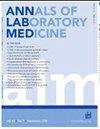唑氟菌素和索红霉素对韩国淋病奈瑟菌的体外活性研究。
IF 3.9
2区 医学
Q1 MEDICAL LABORATORY TECHNOLOGY
引用次数: 0
摘要
不断开发新的抗微生物药物,以应对耐多药淋病奈瑟菌的全球威胁。有希望的候选药物包括唑氟霉素和可能的索红霉素。我们评估了它们对韩国收集的淋球菌分离株的体外活性。使用CLSI琼脂稀释法,利用2016年至2018年在韩国各地获得的250株淋病奈瑟菌分离株,确定了10种治疗剂的最低抑制浓度(mic)。大多数分离株(94.8%,237/250)对青霉素G、四环素和环丙沙星不敏感,对头孢曲松和大观霉素的敏感性相当高。唑氟哌啶的半最大IC值(MIC50)和90% IC值(MIC90)分别为0.03和0.06 μg/mL;索罗霉素分别为0.06、0.12 μg/mL;头孢曲松分别为0.03、0.12 μg/mL。值得注意的是,尽管唑氟达星和环丙沙星都靶向DNA拓扑异构酶II酶,但并未观察到交叉耐药。唑氟西林和索红霉素在体外对多药耐药淋病奈瑟菌具有显著活性,在临床3期试验中,唑氟西林显示出头孢曲松/阿奇霉素双药治疗的非劣效性。总的来说,我们的研究结果强调了唑氟达星作为一种新型淋球菌感染治疗剂的潜力,特别是在多药耐药性不断上升的背景下,并强调了继续监测和开发替代抗菌策略的必要性。本文章由计算机程序翻译,如有差异,请以英文原文为准。
In-vitro Activities of Zoliflodacin and Solithromycin Against Neisseria gonorrhoeae Isolates from Korea.
Novel antimicrobial agents are continually developed to address the global threat of multidrug-resistant Neisseria gonorrhoeae. Promising candidates include zoliflodacin and, possibly, solithromycin. We evaluated their in-vitro activities against gonococcal isolates collected in Korea. In total, 250 N. gonorrhoeae isolates obtained across Korea between 2016 and 2018 were used to determine the minimum inhibitory concentrations (MICs) of 10 therapeutic agents using the CLSI agar dilution method. Most isolates (94.8%, 237/250) demonstrated non-susceptibility to penicillin G, tetracycline, and ciprofloxacin, and susceptibility to ceftriaxone and spectinomycin was substantially high. The half-maximal IC (MIC50) and 90% IC (MIC90) values for zoliflodacin were 0.03 and 0.06 μg/mL, respectively; 0.06 and 0.12 μg/mL, respectively, for solithromycin; and 0.03 and 0.12 μg/mL, respectively, for ceftriaxone. Notably, no cross-resistance was observed between zoliflodacin and ciprofloxacin, despite both targeting DNA topoisomerase II enzymes. Zoliflodacin and solithromycin demonstrated significant in-vitro activity against multidrug-resistant N. gonorrhoeae isolates, and zoliflodacin has shown non-inferiority to ceftriaxone/azithromycin dual therapy in a clinical phase 3 trial. Collectively, our findings highlight the potential of zoliflodacin as a novel therapeutic agent for gonococcal infections, particularly in the context of rising multidrug resistance, and highlight the need for continued surveillance and development of alternative antimicrobial strategies.
求助全文
通过发布文献求助,成功后即可免费获取论文全文。
去求助
来源期刊

Annals of Laboratory Medicine
MEDICAL LABORATORY TECHNOLOGY-
CiteScore
8.30
自引率
12.20%
发文量
100
审稿时长
6-12 weeks
期刊介绍:
Annals of Laboratory Medicine is the official journal of Korean Society for Laboratory Medicine. The journal title has been recently changed from the Korean Journal of Laboratory Medicine (ISSN, 1598-6535) from the January issue of 2012. The JCR 2017 Impact factor of Ann Lab Med was 1.916.
 求助内容:
求助内容: 应助结果提醒方式:
应助结果提醒方式:


